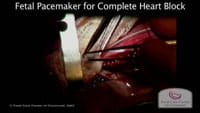Treatment for hypoplastic left heart syndrome begins with rapid stabilization immediately after a child is born. Stabilization measures include the insertion of catheters and use of medications to keep open the communication between the left and right atria and optimally balance the flow of blood through the baby’s heart, lungs and the rest of the body. Treatment options would then include a series of operations, usually three, to reconfigure the child’s cardiovascular system to be as efficient as possible despite the lack of an adequate left ventricle. A heart transplant is a less common treatment option.
For a baby with HLHS and RAS, immediate treatment would include placing a catheter in the baby’s heart to create or enlarge the internal communication between the left and right atria and facilitate the flow of blood out of the lungs. This procedure is known as a catheter-based atrial septoplasty.
Mortality is high among infants who have atrial septoplasty after birth. These infants are usually very unstable, with severe hypoxemia (not enough oxygen in the blood) and acidosis (too much acid in the blood), complicating treatment. Even with successful placement of the catheter, mortality ranges from 48 to 64 percent, with many dying while awaiting reconstructive surgery or a heart transplant.





